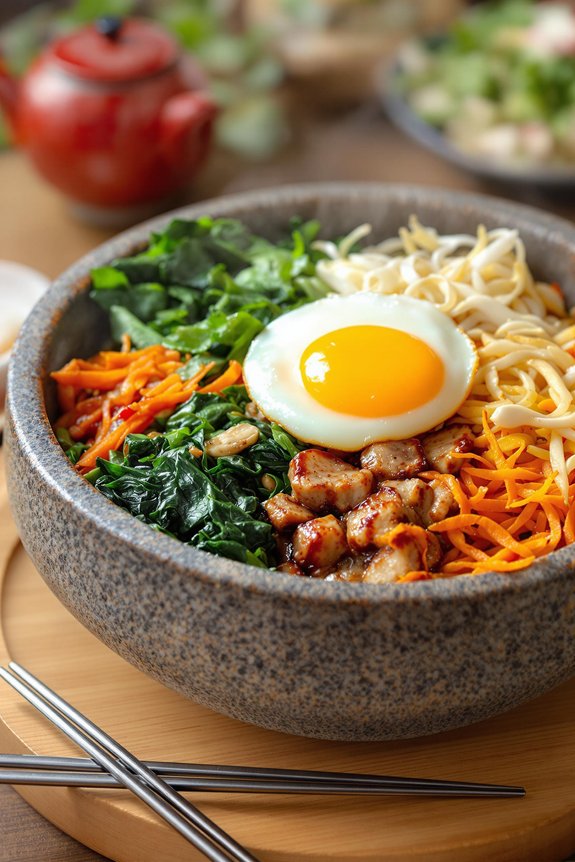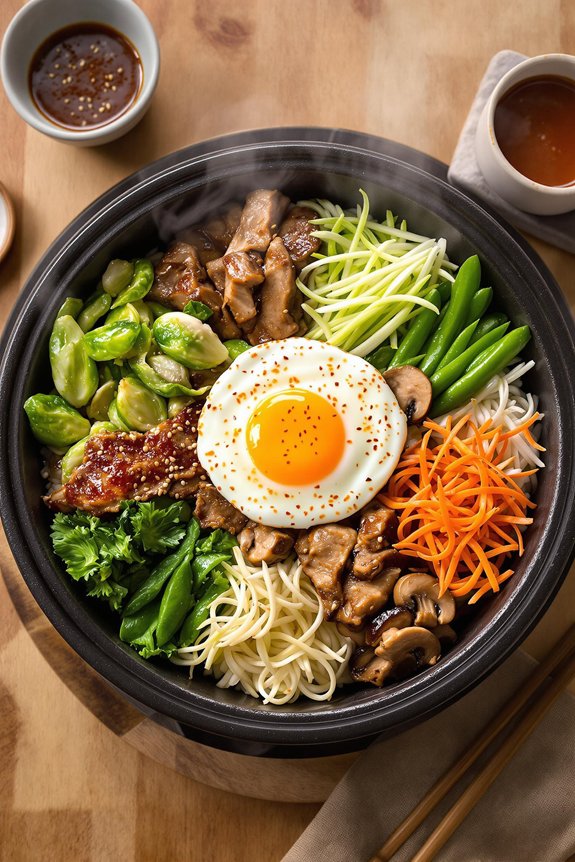Why You’ll Love this Sizzling Korean Pork Bibimbap
If you’re in the mood for a feast that’ll make your taste buds dance, this Sizzling Korean Pork Bibimbap should be at the top of your must-try list. The combination of tender marinated pork, colorful vegetables, and that perfectly runny egg creates a bowl that’s as beautiful as it’s delicious.
What makes this dish so special? It’s the perfect balance of textures and flavors—spicy gochujang paste, nutty sesame oil, and the satisfying crunch of fresh vegetables. Plus, you can customize it based on what’s in your fridge. Need a show-stopping meal for guests? This is it.
What Ingredients are in Sizzling Korean Pork Bibimbap?
The heart of any great bibimbap lies in its vibrant mix of ingredients, each bringing their own texture and flavor to the party. This recipe strikes that perfect balance between protein, vegetables, and seasonings that make Korean cuisine so addictive.
The combination might look intimidating at first glance (I always find myself double-checking the shopping list), but once you gather everything, the magic really happens when these ingredients come together.
- 1 lb pork tenderloin
- 8 ounces Brussels sprouts
- 6 ounces bean sprouts
- 8 ounces shiitake mushrooms, sliced
- 2 large carrots, shredded
- 4 ounces snap peas
- 3 ounces sesame oil
- 3 tablespoons Chinkiang vinegar
- 3 ounces olive oil
- 6 tablespoons gochujang
- 3 tablespoons sugar
- 3 teaspoons apple cider vinegar
- 2 tablespoons sesame seeds
- 3 garlic cloves, grated
- 3 teaspoons ginger, grated
- 6 large eggs
- Rice (amount according to preference)
One thing to keep in mind about these ingredients is their flexibility. Can’t find Chinkiang vinegar? Rice vinegar makes a decent substitute. Not a fan of Brussels sprouts? Spinach or zucchini work beautifully too.
The gochujang paste is really the non-negotiable star here—it provides that signature Korean heat and depth that ties everything together.
And while traditional bibimbap often uses different vegetables, this version with Brussels sprouts and snap peas brings a wonderful seasonal twist that complements the tender pork perfectly.
How to Make this Sizzling Korean Pork Bibimbap

The journey to bibimbap bliss starts with the gochujang paste, which acts as the flavor foundation for this entire dish. In a bowl, combine 6 tablespoons of gochujang with 3 tablespoons of sugar, 3 grated garlic cloves, 3 teaspoons of grated ginger, 3 teaspoons of apple cider vinegar, 3 tablespoons of Chinkiang vinegar, and 3 ounces of sesame oil. This vibrant red paste becomes your secret weapon, adding layers of sweet, spicy, and umami goodness to every component.
Next, trim any excess fat from your 1 lb pork tenderloin and cut it into ½-inch chunks. Coat the pork pieces in just enough of your freshly made gochujang paste to cover them evenly, then tuck them away in the refrigerator for at least 4 hours—though honestly, the longer the better for flavor development.
When you’re ready to cook, heat 1 tablespoon of olive oil in a medium-hot wok and cook the marinated pork chunks on both sides until they develop a beautiful caramelized exterior. Set the pork aside, covered, and prepare to use the same wok for the vegetables (this step is essential—those leftover pork bits in the pan will infuse everything with incredible flavor).
Steam your 8 ounces of Brussels sprouts and 4 ounces of snap peas separately for about 10 minutes, then begin the component cooking process. Working with one vegetable type at a time, toss with a small amount of your gochujang paste, then cook in the wok for a few minutes. The 8 ounces of Brussels sprouts (cut into chunks) and 6 ounces of bean sprouts typically have enough moisture to cook without additional oil, while the shredded carrots, snap peas, and shiitake mushrooms might need a splash of the remaining olive oil to cook properly.
Remember to set each vegetable aside in separate containers after cooking—this isn’t a stir-fry, after all!
For an even silkier texture in your gochujang paste, consider using a Vitamix professional blender to thoroughly integrate all ingredients into a perfectly smooth consistency.
The final assembly is where the magic happens. Cook your rice according to preference and add enough to cover the bottom of each serving bowl (bonus points if you have traditional dolsot bowls that can be warmed).
Arrange your colorful cooked vegetables and pork in separate wedges around the bowl—think of creating a color wheel of deliciousness. The crowning glory comes with the sunny-side-up egg; add a bit of oil to your pan and cook 1 large egg per serving until the white is just set but the yolk remains gloriously runny.
Place this gently atop your assembled bibimbap and serve immediately, encouraging everyone to mix everything together before diving in. That moment when the egg yolk breaks and coats everything with its richness? Pure culinary poetry.
Sizzling Korean Pork Bibimbap Substitutions and Variations
While traditional bibimbap calls for specific ingredients, adapting this sizzling Korean pork version to your pantry or dietary needs is absolutely doable—and I’m here to help you make it work!
Can’t find pork tenderloin? Chicken thighs or firm tofu work beautifully. Vegetarians can skip the meat entirely and double up on mushrooms for that umami punch. No Brussels sprouts? Try spinach or kale instead. For the gochujang paste, sriracha mixed with miso can substitute in a pinch, though it won’t have that same fermented depth. And remember, the separate cooking method matters more than exact vegetables—it’s what gives each component its distinct flavor.
What to Serve with Sizzling Korean Pork Bibimbap
Now that you’ve mastered the basics and possible substitutions, let’s talk about creating a complete Korean dining experience around your bibimbap.
I love pairing bibimbap with traditional banchan (side dishes) like kimchi, pickled daikon radish, or cucumber salad.
A light miso or doenjang soup makes the perfect starter. For beverages, nothing beats a cold Korean beer or soju to balance the spicy gochujang paste. Can you imagine the flavor symphony?
For dessert, keep it simple with sweet rice cakes or fresh fruit. The contrast between spicy bibimbap and something cooling is absolutely divine.
Final Thoughts
After spending time creating this vibrant Korean pork bibimbap, I’m confident you’ll find it worth every minute of preparation. The combination of tender marinated pork, crisp vegetables, and that perfectly runny egg creates a bowl that’s both nutritious and incredibly satisfying.
What makes bibimbap special is how it brings together distinct flavors and textures that you can mix according to your preference. Don’t feel constrained by tradition—add more gochujang if you like heat, or swap in seasonal vegetables that appeal to you.





